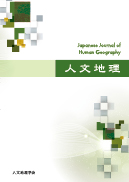
- Issue 6 Pages 477-
- Issue 5 Pages 371-
- Issue 4 Pages 283-
- Issue 3 Pages 187-
- Issue 2 Pages 107-
- Issue 1 Pages 1-
- |<
- <
- 1
- >
- >|
-
Shigeru Kobayashi2015Volume 67Issue 6 Pages 477-479
Published: 2015
Released on J-STAGE: January 30, 2018
JOURNAL FREE ACCESSDownload PDF (964K) -
Shigeru Kobayashi2015Volume 67Issue 6 Pages 480-502
Published: 2015
Released on J-STAGE: January 30, 2018
JOURNAL FREE ACCESSTracing the development of modern mapping in East Asia requires reviewing Western imperial maps and cartographic surveys, which were initiated on the coasts and gradually advanced inland. This paper categorizes the surveys carried out into four types and examines them chronologically.
Surveys by diplomatic missions such as the Macartney Embassy to China were the first type to be conducted. In the aftermath of the Opium War, a number of armed conflicts arose concerning trade between Western countries and East Asian countries, giving rise to the second type of survey: wartime surveys. Western countries subsequently opened legations and consulates in East Asia; surveys spearheaded by diplomatic officials stationed at these outposts comprise the third type. The fourth type of survey to emerge was cadastral and topographical surveys undertaken in colonies.
It is remarkable that in East Asia, native inhabitants were mobilized to survey colonies and imperial maps were translated for their use. These attitudes about mapmaking would seem to undermine the notion that imperial cartography implies the exclusion of people from the mapped county from both making and using maps. To facilitate a consistent understanding, the paper suggests that the long tradition of cartography in this area must be taken into account.
View full abstractDownload PDF (8767K) -
Kunitada Narumi, Shigeru Kobayashi2015Volume 67Issue 6 Pages 503-523
Published: 2015
Released on J-STAGE: January 30, 2018
JOURNAL FREE ACCESSFor Western countries, armed conflicts with East Asian countries were one of the most important opportunities to extend their modern mapping. Reviewing the conflicts that broke out during the 19th century, we found records of mapping and actual maps produced in almost all these cases. Taking the Arrow War as an example, this article intends to study wartime mapping in China by Western countries and understand its prominent features. First, mapping works of the British military during the important armed conflicts in this war are described chronologically. Second, its mapping is examined from a cartographical point of view. Third, French mapping during this war is reviewed by scrutinizing military histories of its army and navy. Finally the translation of these maps and charts into Chinese and Japanese is compared to observe the use of imperial maps in later times.
In this war, the hydrographic and geographic information accumulated by Western countries since Macartney’s embassy to China was reviewed, utilized, and revised. In addition, the imperial mapping in this war was not completely cursory or temporary. Instead, it was carried out in order to secure a “positional accuracy” to serve combat units as much as practicable, and survey data obtained was utilized especially for updating charts. Meanwhile, the French tradition of deploying scientists in expeditions since Napoleon’s occupation of Egypt was also followed in this war. As for the translation of maps and charts, a stark contrast is found between China and Japan.
View full abstractDownload PDF (10377K) -
Daiju Koseki2015Volume 67Issue 6 Pages 524-540
Published: 2015
Released on J-STAGE: January 30, 2018
JOURNAL FREE ACCESSJapan was the first country in East Asia to carry out a series of reforms for the establishment of a modern cadastral system. In 1872, the Meiji Government started to implement several policies related to the Land Tax Reform, including the preparation of cadastral maps. However, it had to change the initial reform plan and remold the form of cadastral maps several times up to 1890. The complete replacement of the old regime for the registration and taxation of land with a modern system was an unexplored task in East Asia, and the Meiji Government had to search for a proper course. This study traces the complicated process of these reforms and follows up on the application of the lessons from this progression in East Asia.
In Japan, farmers usually participated in the survey of taxed land during the Tokugawa period. The Meiji Government carried on this old practice under many constraints. As a result, modern technology such as plane-table surveying was introduced gradually and applied unevenly, according to local conditions. In many areas, cadastral maps produced on the basis of early modern cartography were utilized for land registration even after 1890.
In Japanese colonies (Taiwan, Korean Peninsula, and the Kwantung District), the bureaucrats in charge of land registration profited from this experience of reform in mainland Japan and established organizations made up of specialists including surveyors for this task. The plane-table survey in combination with triangulation became standard.
View full abstractDownload PDF (5584K) -
2015Volume 67Issue 6 Pages 541-542
Published: 2015
Released on J-STAGE: January 30, 2018
JOURNAL FREE ACCESSDownload PDF (952K)
-
[in Japanese]2015Volume 67Issue 6 Pages 543-544
Published: 2015
Released on J-STAGE: January 30, 2018
JOURNAL FREE ACCESSDownload PDF (968K) -
[in Japanese]2015Volume 67Issue 6 Pages 545-546
Published: 2015
Released on J-STAGE: January 30, 2018
JOURNAL FREE ACCESSDownload PDF (969K)
-
2015Volume 67Issue 6 Pages 547-552
Published: 2015
Released on J-STAGE: January 30, 2018
JOURNAL FREE ACCESSDownload PDF (971K)
- |<
- <
- 1
- >
- >|